Talk about an anticipated comic! While enthusiasts are waiting impatiently for the launch of THE BLACK BEETLE #1-4, “No Way Out”, starting on January 16th from Dark Horse, those who missed the three part installments of “Night Shift” in DARK HORSE PRESENTS #11-13 can catch it in rather glorious collected format in issue 0.
Eisner and Eagle Award winner Francesco Francavilla, veteran of SCALPED, ZORRO, and DETECTIVE COMICS, and BEETLE creator is still a “newcomer”, though that’s increasingly hard to believe. BLACK BEETLE started out on Francavilla’s Pulp Sunday Blog but has moved rapidly into “cult classic” status due to its nostalgic roots in pulp detective fiction and film, but also, let’s face it, because of Francavilla’s simply stunning artwork. Francavilla has a sensibility as grounded in design tradition as innovation, as “Night Shift’s” cover and film-poster title page attest.
Most of the chatter from Francavilla and his BEETLE editor Jim Gibbons focuses on the influence of “pulp and noir films”, but like those films, the scripting and the subtext conjure the shade of Dashiell Hammett or Raymond Chandler, including the appellation “a Mystery Novellete” for “Night Shift”. One of the most charming features of the collected issue 0 is the letter page, translated into the lingo of “WCCR: Colt City Radio”, where Gibbons takes on the role of a radio announcer addressing the reader and those who write in to praise the work. Between the film-poster covers and the radio days letter page you’ll find a tale scripted and drawn by Francavilla that he describes as “spy-war” and “supernatural” in genre.
[Warning: spoilers ahead!]
What could be more pulp than starting off with a mysterious object steeped in Egyptian “dark magic”, the “hollow lizard” amulet? Francavilla brings thousands of years of covert history up to date within the first “chapter” of the comic by introducing the Black Beetle as an unseen narrator and introduces a possible recurring character in Dr. Antonia Howard who has the unusual fortune or misfortune (you decide) of recognizing the recently archived amulet at Colt City’s Natural History Museum. It’s a remarkable feat of compression that also bears the stamp of a pulp aesthetic: to serialize a tale without watering down detailed content. The comic itself is an encyclopedia of the strange, from the amulet itself, to helicopter-pack Nazis descending from the sky, but readers will probably continue to recall most vividly Francavilla’s poster-like page compositions both in single and double-page spreads.
The descent of the heli-pack Nazis introducing the role of the Third Reich is a startling image, and a well-balanced 8 panel page depicting Antonia Howard’s muted escape attempt from the museum has color and shadow so well blocked out in mostly silent panels that it could easily be used to advertize the comic, character, and upcoming series. Chapter 2’s double-page historical odyssey giving the history of the Nazi-coveted amulet, narrated by the Black Beetle, is a visual feast that breaks free from panel design toward a cinematic feel, only it would be an arcane task for a film to convey so much information in a single scene. It’s Francavilla’s compression at work again, a skill that nevertheless does not stint on visual spectacle.
Francavilla also has an uncanny instinct for decompressing the narrative at and giving the reader room to breathe during action sequences. An explosion at the museum receives a full-page spread while the Black Beetle’s fire-fight with one of the Third Reich’s “Werewolf Korps” not only receives a double page spread with inset detail panels, it also bristles with sound effects in a hail of gun fire. This may be one of the most skillfully drawn shoot outs you’ll see in the next few months, that is, unless BLACK BEETLE #1 trumps Francavilla’s previous achievements.
In keeping with the standard set by the artwork, there are a few other aspects of scripting that are particularly masterful in “Night Shift”. Firstly, the story is a mystery at heart, and just as it opens with a mysterious object narrated by an unseen figure, it concludes with an even greater mystery: the use of that object in some kind of occult machine, placed there by the Black Beetle no less. Francavilla knows how to keep the impetus for the series alive by conserving the Black Beetle’s knowledge of events, and handing him the reigns of what to reveal, and what not to reveal, to the reader. Secondly, the role of violence escalates throughout #0’s three chapters. At first, readers see the “Werewolf Korps” coldly carrying out their “no witnesses” policy, but only observe the Black Beetle pistol-whipping a “werewolf” at the museum. By the time that mode has failed, the Beetle not only engages in a close-range firefight, but picks off the assassins with execution-style marksmanship.
The escalation in violence is not purely employed for the sake of spectacle; it also raises the tone of seriousness in the comic. What may have seemed, at times, like a romp through the pulp genre escapes irony or parody by becoming deadly serious. It places the Black Beetle character at the center of a conspiracy that is both “spy-war” and “supernatural” in genre and takes no prisoners. It would be all too easy for the remastering of pulp elements to become ironic, comic, or even parodic, but Francavilla takes readers down a different path. It’s all the more impressive that he does this with a “masked hero” who has a name not particularly predatory in nature.
Lastly, Francavilla breaks away from stereotyped Nazi villains through grounding their activity in technology. While the helicopter packs may be slightly more fanciful and introduce a wonder element to the relentless assassins, it’s the simple technology that brings Black Beetle’s nemeses to life. The final page of the comic illustrates this when the unnamed occult supervisor plays over and over again a “radio” recording of a conversation between Antonia and the Black Beetle. The replayed audio is disturbing, perhaps more disturbing than the heli-packs or “Werewolf Korps”. It makes you wonder, and of course, want to know more in future installments of the comic, about who or what exactly is listening in on the Beetle’s exploits.
It’s no surprise that readers following the 3 part-serialization of “Night Shift” in DARK HORSE PRESENTS have been waiting to find out what exactly is going on since Francavilla sets up his mystery with such precision and with such overwhelming visual style. He proves that a good, old-fashioned adventure story can still raise the bar in comics, whatever genres one may care to throw into the mix. Jim Gibbons predicts, in his “Colt City Radio” broadcast that readers will become “Beetlemaniacs” before long. As gutsy as that claim sounds, BLACK BEETLE certainly has the potential to become an enduring “cult classic”, inspiring readers to roll up for more “twisted thoughts” from Francavilla in 2013.
Hannah Means-Shannon writes and blogs about comics for TRIP CITY and Sequart.org and is currently working on books about Neil Gaiman and Alan Moore for Sequart. She is @hannahmenzies on Twitter and hannahmenziesblog on WordPress.


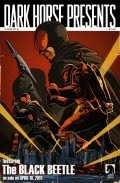

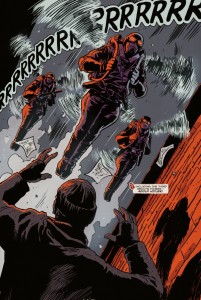
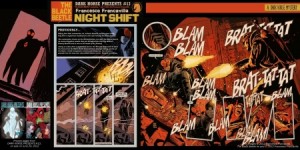
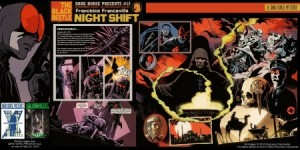
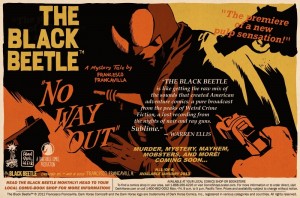
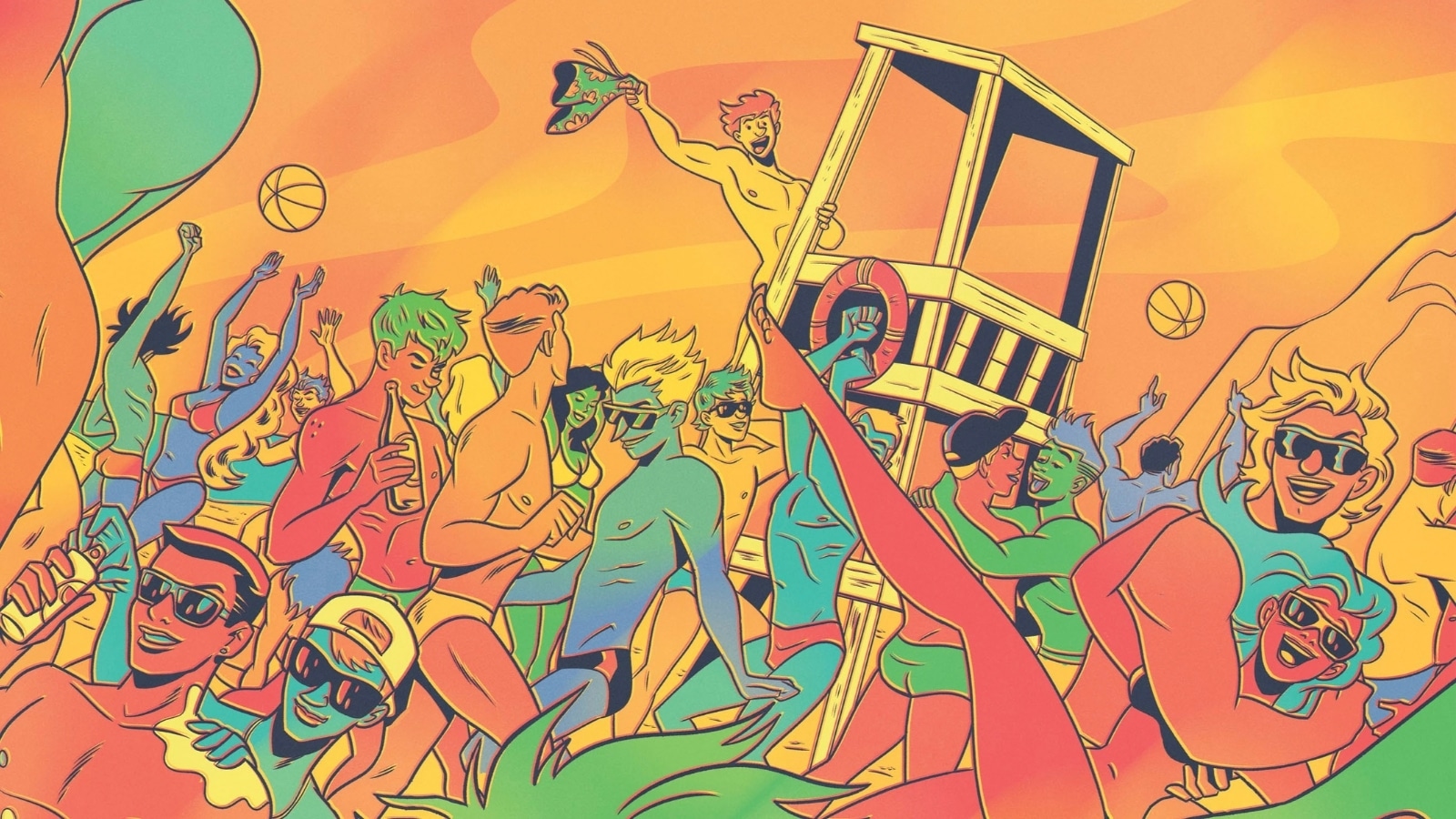

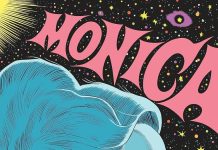



RT @Comixace: Review: THE BLACK BEETLE #0, Night Shift: http://t.co/GEgD9Iei
Great issue, with wonderful artwork (no surprise there). If this is what the follow up series will be like, then it promises to be very good.
Comments are closed.